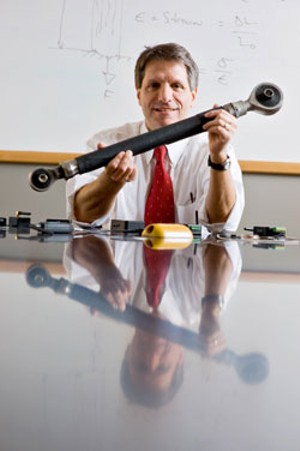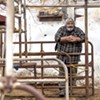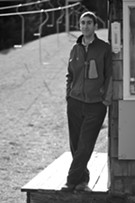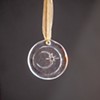Published January 23, 2008 at 11:15 p.m.
Human beings have the dubious distinction of knowing when they’re hurt. Endowed with an intricate and wondrous nervous system, we are capable of registering sensations on the wide spectrum between ecstasy and misery. Coupled with that, we have the instinct and ability to fix ourselves when we sense something’s amiss. Ironically, many of the things we trust to keep us safe — bridges and airplanes, for instance — are as dumb as doorknobs. A bridge truss doesn’t know when it’s about to fail, just as a plane’s wing can’t predict its own catastrophic demise.
MicroStrain, a rapidly growing company located in a nondescript office park in Williston, is, in a manner of speaking, making doorknobs wise. Founded 21 years ago by Burlington native Steve Arms, the company designs high-tech strain gauges that measure the stress loads on all kinds of objects, from knee joints and helicopters to bridges and Caterpillar Earthmovers.
The gauges, many of which are housed in compact black boxes the size of a pack of Post-it Notes, allow engineers to determine the structural health of metals and plastics, and thereby avert failures. They can also help avoid premature replacement of expensive, taxpayer-funded toys such as F-18 fighter jets. In addition, MicroStrain makes $1500 orientation sensors that can navigate unmanned vehicles in any imaginable application, such as oil exploration, underwater research and landmine detection.
All of these magical gadgets are conceived and designed in a 10,000-square-foot office overlooking I-89, with a peaceful, long view beyond. Arms, 48, has family that goes back a long way in Chittenden County: Willard Arms, Steve’s grandfather, had a dairy farm where Burlington High School sits today.
Arms got his undergraduate degree in engineering from the University of Vermont. While there, he became interested in orthopedic biomechanics — the study of the bones, ligaments and muscles that hold our bodies together. After his freshman year, Arms got a work-study job with Dr. Robert Johnson, a now-retired orthopedist who did a lot of knee operations. That first job set the tone for the rest of Arms’ career, because it gave him the training and the impetus to design the predecessors of the gauges MicroStrain builds today.
“I learned a ton about how to do research,” Arms says of his job with Johnson, “how to ask a question, and how to develop a research plan to get answers to those questions.” One of his early assignments was to figure out how ligaments stretch and how that stretching affects their strength. “But what I learned,” Arms recalls, “is that nobody knew what the loading was in a live human, because no one had the right tools to measure it.”
That led Arms to take a shot at fabricating the sensors himself — devices that would show, in numerical form, the quantity of stress that ligaments undergo in a host of movements. And he did it. “We actually developed ways of implanting these strain gauges into the human body arthroscopically,” Arms explains. It was the first time anyone had taken strain measurements of live humans, and UVM won numerous awards for the work.
Arms stayed at the university to work on his graduate degree in mechanical engineering. He started presenting his findings about strain forces on the anterior cruciate ligament (ACL), an important knee ligament that skiers commonly injure. “I’d be making these presentations and people would say, ‘Where did you buy those sensors?’” Arms says. “And I said, ‘Well, I didn’t buy them, I made them.’” Shortly thereafter, Arms began building the sensors in his Park Street apartment and shipping them all over the world. A somewhat destitute student at the time, he recalls, “It was nice making extra money this way.”
As much as he loved orthopedic biomechanics, Arms’ aptitude with the sensors encouraged him to follow a path less limiting. “I really wanted to concentrate on the sensing, the electronics, and making the sensors better, and adapting them for other applications,” he says. So, in 1986, Arms wrote a Small Business Innovation Research grant proposal, and got $50,000 from the federal government to do the sensor work that truly interested him. “As a grad student, that seemed like a lot of money,” he says. Indeed, it was enough for him to leave UVM just shy of a PhD and start MicroStrain in January 1987.
************
Twenty years later, MicroStrain is posting annual revenues of more than $7 million. That success is due, Arms explains, to “hiring smart people and getting out of their way and letting them do their jobs.” For example, take Chris Townsend, 41, the executive vice president of engineering. He grew up in Newfane and has been with Arms nearly since the company’s formation — he started while he was studying electrical engineering at UVM and Arms was making sensors in the Old North End. “He’s a quick learner, a smart guy, and was able to do things that I couldn’t do, because of his background,” Arms says.
Townsend remembers that it was tough working for a start-up operation at first: “I used to drive a bagel truck in the morning and come into work during the day, even after school was over, because we were a small company trying to grow.” But small is where it’s at, he says. “It’s really exciting to get in early with a company. And most of the tech companies in this area are really small, so there’s actually a lot of opportunity around here.”
Justin Bessette, 27, a wireless design engineer from Essex, was MicroStrain’s first intern from UVM. “Justin’s the model we want to replicate,” Arms says enthusiastically. “Hire smart kids out of UVM, train them through their undergraduate years, and then have them drop into the company when they graduate.”
Indeed, Bessette started at MicroStrain after his freshman year, worked there during school and over the breaks, and had a job waiting for him when he graduated. While his classmates mostly had to leave the state, Bessette says, “I got to stay in Vermont, which was key, because I really love it here.”
What happens when you let eager engineers and computer scientists go wild in a laboratory? They develop things like wireless, energy-harvesting stress-detection systems for helicopter linkages. “You could think of this as a kind of nervous system for a helicopter,” Arms analogizes, affording easier maintenance, longer life and safer operation. Wireless, because the linkages are spinning and would tangle wires in short order; energy harvesting because, as Arms asks, “Who’s going to maintain all those batteries?”
Those were the basic problems the Navy asked MicroStrain to solve through two contracts, awarded in 2006 and 2007, worth $3.7 million. “And we did,” Arms says. “We developed energy-harvesting sensors that take the strain energy and convert it into power.” In other words, by using piezoelectric material that turns vibrations and strain into energy, MicroStrain designed sensors that are powered by the very movement of the objects they’re gauging.
MicroStrain tested the sensors on a Bell helicopter last year and they passed with, um, flying colors. The task now is twofold: designing a system for an entire fleet that meets the military’s stringent standards, and building data aggregators that can handle networks of sensor nodes and be interrogated in a secure fashion via cellphones and satellites. Arms says MicroStrain is also working on an application to make civilian aircrafts safer, but he isn’t at liberty to elaborate.
An application with just as much promise as the helicopter linkage sensor is a system designed to monitor the structural integrity of bridges. These, too, are wireless, which cuts down on cost and makes the system more durable, in addition to “being a kind of website,” Arms explains, “collecting data by itself” that civil engineers can analyze for excessive strain.
MicroStrain, in one of its first implementations of the bridge sensors, provided a strain-gauge system for the Ben Franklin Bridge between Camden, New Jersey, and Philadelphia. The Delaware River Port Authority was contemplating an expensive restructuring job after they sandblasted the old lead paint and saw structural material coming off. But the sensing data showed the bridge’s strain levels were within safe limits, which meant it didn’t need the $2 million repair job. The cost of that knowledge, at $30,000, turned out to be well worth it.
Similar systems are in place on the Corinth Canal Bridge in Greece, where seismic activity is frequent, and the Goldstar Bridge on I-95 in Connecticut. But what’s to stop states from putting sensors on all bridges? “Money,” Arms says. “The departments of transportation are not funded to put monitoring systems on bridges.”
The Vermont Agency of Transportation, however, has ordered four sensors from MicroStrain, to determine if a further investment is warranted. AOT spokesman John Zicconi says, “Bridge inspectors are trained to do a lot by sight and feel. But having actual information to go along with their senses can be an aid.” He adds that the AOT has already used MicroStrain sensors in the Jersey-barrier-replacement project on I-89 through Bolton. “In order to figure out the new design, we wanted to figure out the problems with the old design.” The problems, Zicconi says, caused the barriers to creep towards each other and crumble.
Being sensitive, it turns out, is good for business. Over the past two years, MicroStrain has enjoyed between 35 and 40 percent growth in product sales, even though only 18 percent of its revenue comes from government contracts. “We’re not trying to be guns for hire,” Arms explains. “We want to build products that have wide applicability across many fields.”
The Vermont Tech Biz Issue
VIDEO: The Campus Question: St. Michael's College
More By This Author
Speaking of...
-

The Pending Sale of Williston's Isham Family Farm Exposes Fragility in the Agricultural Succession Model
Mar 26, 2024 -

Pair Will Share Oaxacan Heritage at El Comal in Williston
Jan 9, 2024 -

Video: Dr. Rachael Floreani & Irfan Tahir Discuss the Future of Lab-Grown Meat
Dec 7, 2023 -

Aromas of India Cooks Up Vegetarian Comfort Food in Williston
Oct 24, 2023 -

Seven Sweet Summery Spots for Frozen Treats
Aug 1, 2023 - More »
Comments
Comments are closed.
From 2014-2020, Seven Days allowed readers to comment on all stories posted on our website. While we've appreciated the suggestions and insights, right now Seven Days is prioritizing our core mission — producing high-quality, responsible local journalism — over moderating online debates between readers.
To criticize, correct or praise our reporting, please send us a letter to the editor or send us a tip. We’ll check it out and report the results.
Online comments may return when we have better tech tools for managing them. Thanks for reading.















































